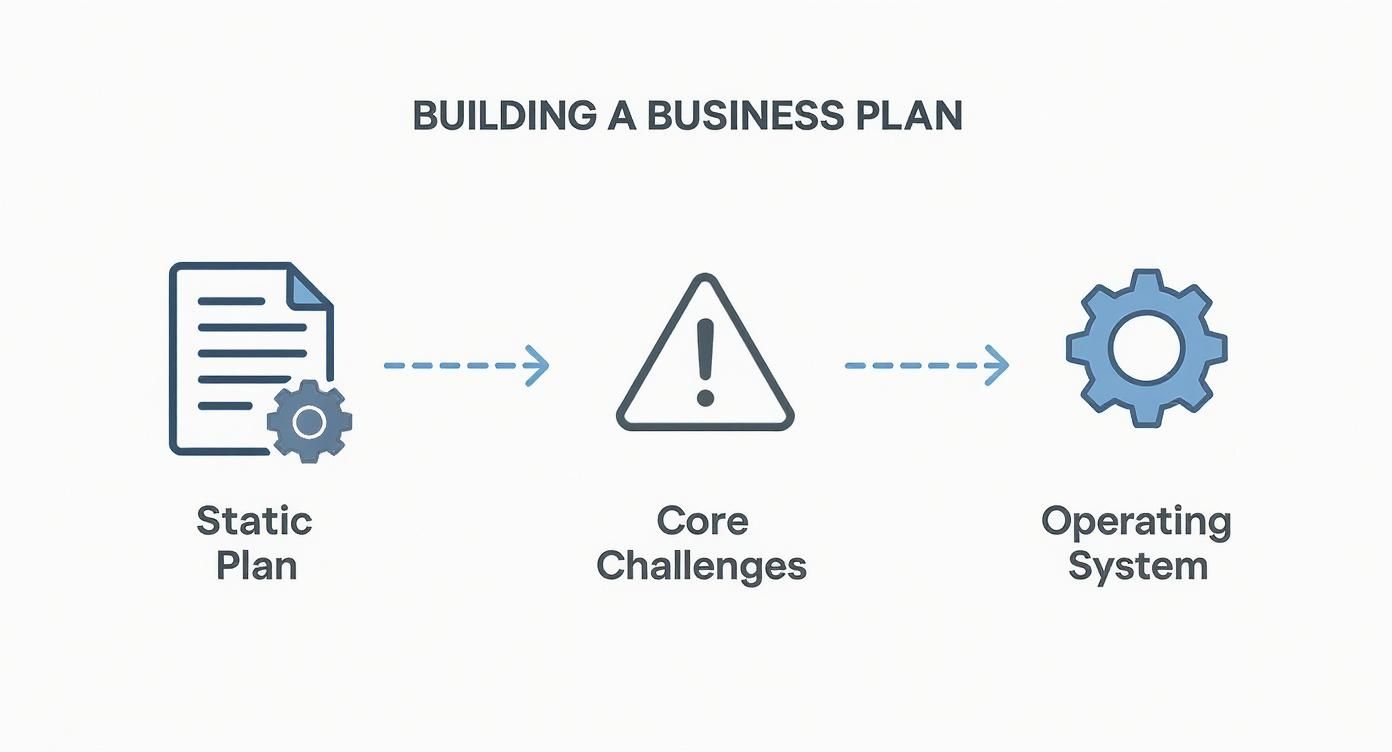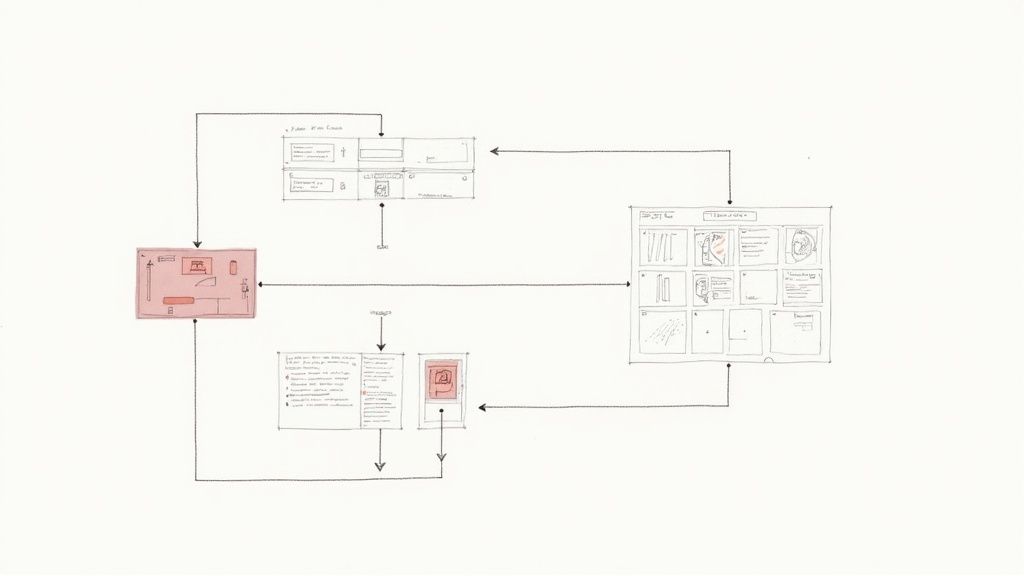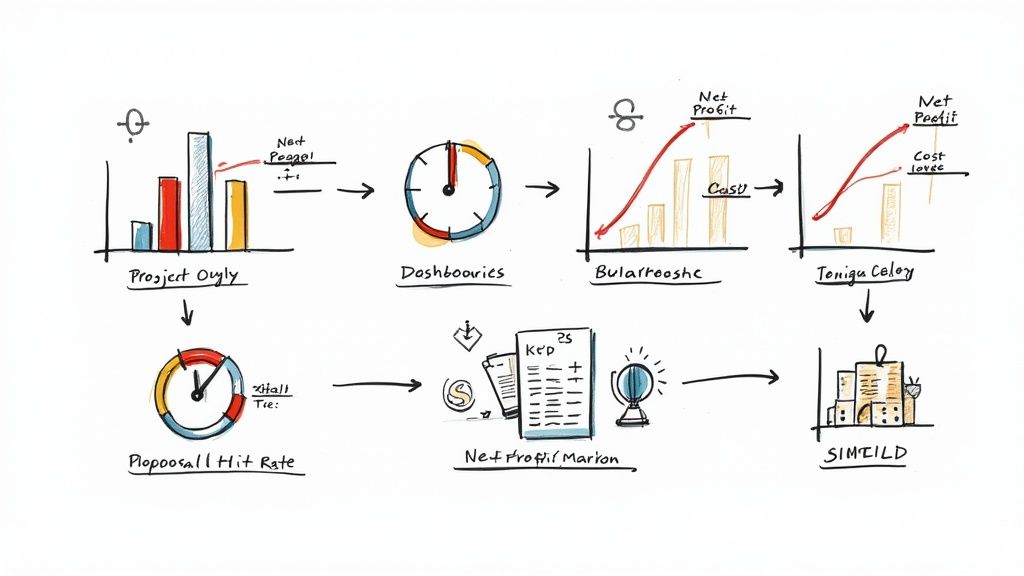The Architecture Firm Business Plan as an Operating Blueprint
An architecture firm business plan isn’t a static document you write once for a bank loan. For principals of small to mid-size firms, it’s a living operating blueprint—a guide built for execution, not just aspiration. It’s the internal logic for how your firm wins work, delivers it with predictable quality, and protects its profit margins.
This is what shifts a practice from a reactive, project-by-project hustle to a mature, intentional operational system.
Your Business Plan Is an Operating System, Not a PDF
Forget the dusty PDF collecting digital dust on a server. The most effective architecture firm business plan is an operating system that dictates how you operate daily. It’s the firm's engine for winning, producing, and delivering work profitably and sanely.
Most founders and principals know this instinctively but get trapped in the daily grind of scattered projects, intense pricing pressure, and late nights fixing markups. This isn’t about generic MBA advice like “define your vision.” This is about designing the delivery engine of your firm to combat the chaos.
We’ve seen firms unlock real growth only when they start treating production as a scalable system, not a talent lottery. This approach directly tackles the core challenges founders face: being over-dependent on a few "hero" designers, having workflows that consistently eat into profit, and reactive hiring that feels like constant firefighting.
The infographic below illustrates this exact shift—from a static plan to a dynamic operating system that solves these real-world problems.

This visual shows how a simple document transforms into a strategic tool that directly confronts the hurdles of running a modern architecture practice.
The Levers of a Modern Firm's Blueprint
Your operating system should be built on a few core, interconnected levers. These aren't just sections in a document; they're the controls you pull to drive the business forward and create stability.
- A Laser-Focused ICP: A clearly defined Ideal Client Profile (ICP) means you stop trying to be everything to everyone. It allows you to build deep expertise, command better fees, and streamline project delivery because you know exactly who you're serving and what they value.
- Scalable Production Systems: This is about standardizing everything from your CAD-to-BIM evolution to your QA processes. It means creating template discipline and decision checkpoints that prevent rework and reduce RFIs. Mastering workflows is non-negotiable, and our guide on how to manage multiple projects offers deeper insights here.
- Predictable Financial Model: This goes beyond a simple P&L. It’s about deeply understanding project-level profitability, protecting your margins with pricing discipline, and aligning staffing with the natural rhythms of your workload.
- Deliberate Talent Strategy: You need a hiring plan that prioritizes long-term capability, not short-term firefighting. The goal is to build repeatable delivery pods—small, effective teams—that can execute consistently without burning out key players.
The real takeaway is this: great architecture firms don’t just design buildings; they design their delivery system. Process protects creativity, and consistency protects profit.
To treat your business plan as an evolving operating system, understanding key digital transformation strategies is paramount for continuous improvement. This mindset ensures your firm remains agile and competitive.
Standardize Production to Unlock Scalable Growth
A resilient architecture firm is built on a reliable production engine, not on heroic late nights and constant firefighting. Your business plan needs to map out exactly how you'll build this system—a system that ensures quality, protects your margins, and makes your delivery predictable.
This is what frees founders from being stuck in the weeds, drowning in endless markups and project emergencies. It allows you to step back and steer the business. When you treat production as a scalable system instead of a talent lottery, you unlock a sustainable architecture practice growth strategy.

The goal is to move from a culture of scattered, one-off projects to a mature firm where process protects creativity and consistency protects profit. This operational backbone is the foundation of your growth.
From CAD Chaos to BIM Clarity
Plenty of firms get stuck in the awkward transition from basic CAD to a mature BIM (Building Information Modeling) workflow. Just saying "we use BIM" isn't a strategy. Your business plan must get specific, detailing how you will standardize its use to drive efficiency and slash errors.
This is about more than 3D modeling. It’s about embedding BIM into your entire production process. You need template discipline, robust QA/QC processes baked into the model, and non-negotiable decision checkpoints to catch issues long before they become expensive surprises on site.
When you get this right, the impact on your bottom line is immediate:
- Fewer RFIs: A mature BIM process lets you spot and resolve clashes digitally, when they're cheap to fix—not when they’re costly RFIs from the field.
- Faster Permitting Prep: Standardized templates and workflows accelerate documentation, helping you get permit sets out the door faster and with fewer redlines.
- Tighter Coordination: A single source of truth in the model sharpens handoffs between disciplines, eliminating the coordination mistakes that eat away at fees.
If you're serious about systematizing this, you need a clear framework. A great place to start is by exploring effective BIM Execution Plans, which are essential for getting the entire project team on the same page.
From Reactive Chaos to Systematized Production
The difference between a firm that's constantly struggling and one that's built to scale often comes down to its operational mindset. One runs on adrenaline and heroics; the other runs on well-defined systems. Here’s how that plays out.
| Operational Area | The Reactive Firm (High Stress, Low Margin) | The Systematized Firm (Predictable, Profitable) |
|---|---|---|
| Project Kickoff | A hurried meeting, unclear scope, "We'll figure it out." | Standardized kickoff checklist, defined roles, crystal-clear client expectations. |
| Technology Use | BIM is just a 3D modeling tool. Inconsistent templates. | Mature BIM workflow with embedded QA. Rigorous template discipline. |
| Quality Control | Relies on one senior person to catch everything at the last minute. | Pre-defined QA/QC checkpoints at key milestones (30%, 60%, 90%). |
| Team Structure | People are thrown at projects based on who is "least busy." | Small, repeatable "delivery pods" aligned to specific project types. |
| Knowledge Capture | "How did we do this last time?" Knowledge walks out the door. | A living "production playbook" codifies best practices and lessons learned. |
The reactive firm might occasionally produce a great building, but the systematized firm can deliver exceptional work predictably. That’s the difference between a practice and a business.
Establish Your Production Playbook
Your firm’s production playbook is its operational blueprint. It's a living document that captures your best practices so that every project benefits from the hard-won lessons of the last one. It’s the definitive answer to, "How do we do things here?"
A great architect can design a beautiful building once. A great firm can deliver exceptional buildings predictably, time and again. The difference is the system.
This isn't about turning your team into robots. It’s about creating a baseline of quality that frees up their mental energy for tough design challenges, not for reinventing the wheel on basic project setup.
Your playbook should include essentials like:
- Project Kickoff Checklists: Ensure every project starts right, with correct info, clear goals, and defined roles.
- Standardized File Structures: A simple but powerful way to eliminate confusion and stop wasting time hunting for files.
- QA/QC Checkpoints: Pre-defined review gates at critical milestones (e.g., 30% SD, 60% DD, 90% CD) with objective criteria for what "done" looks like.
- Template Discipline: Mandate the use of project templates for everything from fee proposals and contracts to drawing sets and specs.
This isn’t about adding bureaucracy. It’s about building a predictable environment where your team can do their best work.
Scale with Repeatable Delivery Pods
One of the most common failure points for growing firms is that quality nosedives as soon as the founder can no longer personally oversee every detail. The solution is to structure your teams into repeatable delivery pods.
Think of a delivery pod as a small, cross-functional team—maybe a project architect, a job captain, and a designer—that focuses on a specific project type that matches your ICP. By working on similar projects again and again, these pods develop incredible expertise and an almost intuitive workflow.
This model is a powerful engine for growth:
- Predictable Staffing: It helps you align hiring with your pipeline, letting you build long-term capabilities instead of making reactive "firefighting" hires.
- Better Mentorship: Junior staff learn the ropes much faster within a consistent, supportive team structure.
- Scalable Delivery: You can add new pods as your workload grows, and quality control stays high because every pod operates from the same playbook.
Standardizing your production is how you design a business that's truly built to scale.
Build Your Financial Framework for Profitability
A mature architecture firm runs on financial clarity, not guesswork. Your business plan must establish a rock-solid financial framework that protects your margins and fuels growth. This isn't just about tracking money; it's about building a predictable economic engine for your practice.
We’ve seen firms unlock incredible stability when they finally get a handle on their financials. They stop competing on price and start making data-driven decisions about which projects to pursue. This is the shift—from just practicing architecture to running a truly profitable business.

This financial discipline ensures your creative work is supported by a healthy bottom line, giving you the freedom to weather market shifts and invest in your team’s future.
Price for Value, Not Just Hours
Many firms fall into the trap of selling hours, which puts a ceiling on your earning potential and throws you into a race to the bottom on fees. It’s a losing game.
Instead, your pricing must reflect the value and outcomes you deliver to your Ideal Client. To do that, you need an honest understanding of your true cost of delivery for different project types. Once you know what it costs to deliver a high-quality commercial interiors project versus a custom home, you can price for a healthy, protected margin.
This shift has a massive impact:
- It moves client conversations away from hourly rates and toward project goals and solutions.
- It forces you to be incredibly efficient, because any wasted effort directly eats into your fixed-fee profit.
- It allows you to build a financial cushion for innovation, better salaries, and strategic investments.
Understanding your real cost of project delivery is also how you spot opportunities for savings. For more on this, check out our guide on https://bimheroes.com/how-to-reduce-construction-costs/, which digs into efficiencies that begin in the design phase.
Track the KPIs That Actually Matter
You can't judge your financial health by your bank balance alone. A well-structured business plan must focus on the KPIs that guarantee long-term stability. The typical net profit margin for A&E firms globally hovers between 10% and 20%, with only the most efficient firms consistently breaking past that.
To stay on the right side of those numbers, you need real-time data. Your proposal hit rate—ideally above 40%—is another critical metric. If it drops, it's a huge red flag signaling wasted effort and potential cash flow problems down the road.
A firm that doesn't track its core financial metrics is flying blind. Predictability isn't about having a crystal ball; it's about having a dashboard with the right warning lights.
These KPIs give you the early warnings you need to make strategic adjustments before small issues turn into major headaches.
Key Metrics for Your Firm's Dashboard
Every firm leader should have a dashboard with a few non-negotiable metrics that are reviewed weekly or monthly. This isn't about getting lost in complex spreadsheets; it's about keeping a pulse on the business.
Here are the essentials:
- Proposal Hit Rate: (Proposals Won / Proposals Submitted). A low rate means you're wasting time on the wrong clients or your value proposition isn't hitting the mark.
- Net Profit Margin: The ultimate measure of profitability. Be sure to track it by project type to see where your real money-makers are.
- Project Backlog: Your pipeline of contracted future work. This is your best predictor of future revenue and staffing needs.
- Utilization Rate: (Billable Hours / Total Hours). This tells you everything about team capacity and efficiency, ensuring you’re staffed correctly for your workload.
To truly build a robust financial framework, implementing data-driven financial modelling for SMBs is what takes you to the next level. These systems turn raw numbers into actionable intelligence, letting you see around corners and make proactive decisions about hiring, business development, and strategic direction.
Ultimately, this financial clarity is what separates firms that merely survive from those that are built to last.
Design Your Go-To-Market Strategy
Effective marketing for an architecture firm isn’t about chasing every lead. It’s a disciplined process, and it starts with a powerful idea: you can’t be the right firm for everyone. A solid business plan outlines a go-to-market strategy built around a laser-focused Ideal Client Profile (ICP).
Trying to land every project that comes your way is a fast track to burnout and razor-thin margins. Instead, focus on a specific niche. Whether it's sustainable multi-family housing or high-tech lab spaces, specialization allows you to build deep, defensible expertise.
This focus is what lets you command higher fees, streamline how you deliver projects, and build a reputation that attracts the right kind of work.
https://www.youtube.com/embed/rgBsk-NAX0I
This isn’t just a marketing decision; it’s a core business strategy. When you know exactly who you serve, every other part of your firm—from your production systems to who you hire—snaps into focus.
Define Your Ideal Client Profile
Your ICP is a crystal-clear, written definition of the client who gets the most value from what you do and, in turn, is the most profitable for your firm. It has to go deeper than broad categories like "developers" or "homeowners." A strong ICP gets specific.
Think about these factors:
- Project Type and Scale: What kinds of projects are your home runs? What’s the sweet spot for project size and budget?
- Client Maturity: Have they worked with architects before? Do they truly value good design and a structured process, or are they just shopping for the lowest price?
- Decision-Making Process: Who holds the purse strings? Who are the key influencers you need to win over? Knowing this helps you tailor every conversation.
- Values Alignment: Do their goals—sustainability, community impact, cutting-edge design—line up with your firm's mission?
Once you have this clarity, your marketing stops being a guessing game. Your messaging becomes sharp and resonant because you're speaking directly to the pains and ambitions of a very specific audience.
Articulate a Value Proposition That Resonates
With a clear ICP in hand, you can craft a value proposition that shifts the conversation away from price and toward partnership. Your clients aren't just buying a set of drawings; they're buying an outcome. Maybe they're looking for reduced operational costs, a faster path to occupancy, or a building that helps them attract top-tier talent.
Your value proposition shouldn’t be about what you do (e.g., "we provide architectural services"). It should be about the result you create for your ideal client (e.g., "we design operationally efficient facilities that reduce long-term costs for healthcare providers").
This shift is crucial. It positions your firm as a strategic partner, not a commodity you can get from anyone. That gives you the leverage to protect your margins and attract clients who see the real value in excellent design.
Create a Repeatable Client Experience Playbook
Your best source of high-quality leads will always be referrals from ecstatic clients. But those referrals don't just happen by magic. They’re the result of a deliberate, consistent, and positive client experience.
Your business plan needs to outline your client experience playbook. This is your documented process for every key touchpoint in the client’s journey, from the first time they call you to the final project closeout. It ensures every client gets the same high level of care and professionalism, no matter who is managing the project.
A well-designed playbook is foundational, and for a deep dive, the ultimate guide to seamless client onboarding for architects provides an excellent framework.
Your playbook should standardize these critical moments:
- Initial Inquiry Response: How quickly do you get back to them? What key information do you gather right away?
- Proposal Presentation: How do you walk clients through your process and clearly demonstrate your value?
- Project Kickoff: What happens in that first meeting to set everyone up for success?
- Ongoing Communication: How often do you send updates? What format do they take?
This kind of system builds immense trust and turns clients into your biggest advocates. It’s how you create a repeatable client acquisition engine that brings in profitable, enjoyable work, freeing you from a constant, stressful reliance on the founder's personal network.
Navigate Market Headwinds and Build Resilience
An architecture firm business plan isn't just a roadmap for growth; it's your firm's shock absorber for the inevitable market downturns. In our industry, resilience isn’t accidental—it’s designed. Building a flexible yet disciplined operational model is what allows smart firms to not only survive soft periods but to emerge stronger, often capturing market share from less prepared competitors.
This means shifting your mindset from reactive cuts to proactive adjustments. A solid plan gives you the foresight to see turbulence ahead and the structure to navigate it without gutting your core capabilities or culture.
Reading the Economic Tea Leaves
Staying ahead of market shifts requires paying close attention to leading economic indicators. For our sector, one of the most critical is the Architecture Billings Index (ABI). When the ABI score drops below 50, it’s a clear warning sign that more firms are reporting a decline in billings than an increase—a signal of a contracting market.
As of mid-2025, the ABI has painted a challenging picture. It has remained below 50 for most of the last three years, signaling a prolonged period of soft business conditions. With new design contracts declining for 18 consecutive months—the longest downturn on record—firms are feeling the pressure. Clients are cautious and hesitant to commit.
This trend hits some areas harder than others. Firms in the Midwest and West are facing particularly tough environments, and those specializing in institutional work are experiencing their weakest conditions since 2020. It's worth exploring a deeper analysis of these market conditions from the AIA to understand the regional and sector-specific headwinds your firm might be up against.
Diversify to Mitigate Sector-Specific Risk
Relying too heavily on a single market sector is one of the fastest ways to become vulnerable. A firm that was exclusively focused on commercial office space, for example, would have been hit exceptionally hard by recent shifts in work culture. Your business plan needs a deliberate strategy for diversification.
This doesn't mean you should abandon your ideal client profile or try to be everything to everyone. It’s about identifying adjacent or counter-cyclical markets where your core expertise is transferable.
- Commercial to Institutional: If your team excels at complex commercial projects, could you pivot that expertise toward publicly funded institutional work like schools or healthcare facilities? These often operate on different funding cycles.
- High-End Residential to Multi-Family: Can your design sensibilities from custom homes be applied to boutique multi-family developments? This sector might stay strong even when single-family demand wanes.
Resilience is built by having options. A diversified portfolio acts as a hedge, ensuring that a slowdown in one area doesn’t cripple the entire firm.
Maintain Disciplined Cash Flow and Backlog Management
During a downturn, cash is king. Your business plan must enforce strict financial discipline. This means having a clear policy for managing cash flow, aggressively pursuing receivables, and securing a healthy line of credit before you actually need it.
Just as important is how you manage your project backlog. A healthy backlog—ideally representing 6 to 9 months of future revenue—provides the buffer needed to weather prolonged soft patches without resorting to layoffs. It’s your firm's early warning system. It gives you time to ramp up business development efforts or make strategic pivots long before a revenue crisis hits. This forward-looking financial management is the bedrock of a firm built to last.
Plan for Your Firm's Future Leadership
A truly sustainable architecture firm is one built to outlast its founders. Yet, succession planning is one of the most neglected parts of an architecture firm business plan. It always feels like a problem for "later," but kicking this can down the road puts your firm’s value, client relationships, and team culture at serious risk.
This isn’t just about a founder’s exit strategy. It's about building institutional knowledge and creating a culture that actually attracts and retains the next generation of leaders.

Without a clear path forward, your firm’s legacy depends entirely on you. A proactive plan is what protects everything you’ve built.
Building Your Leadership Pipeline
Developing future leaders should start years—not months—before you even think about transitioning. It begins by creating clear career paths and delegating real P&L responsibility, not just project tasks.
Give your rising stars ownership over client relationships, fee negotiations, and team management. This is the only way to truly see who has the grit and vision to lead.
Ownership transitions are a massive factor shaping the future of architecture, with a huge wave of retirements on the horizon. It's estimated that over 40% of architecture firms in the U.S. will undergo some form of ownership change by 2030, mostly driven by retiring founders. This generational shift is forcing firms to get serious about leadership development. You can learn more about these architecture firm succession trends impacting the industry.
Exploring Transition Models
There's no one-size-fits-all solution for an ownership transition. Your business plan should explore the model that best fits your firm's culture, financial structure, and long-term goals.
- Internal Promotion: Selling shares to key employees is the most common path. It ensures continuity and rewards the very people who helped you build the firm in the first place.
- Employee Stock Ownership Plan (ESOP): This model transfers ownership to all employees, creating a powerful incentive for retention and performance. It's a complex route but is becoming an increasingly popular option.
- Strategic Merger or Acquisition: Joining a larger or complementary firm can provide a clear exit path and new opportunities for your team, but this requires extremely careful cultural alignment to succeed.
Great firms don’t just happen; they are intentionally designed for continuity. Your succession plan is the final, most important design problem you will solve for your practice.
Proactive planning transforms an exit from a potential crisis into a strategic, value-preserving event. It ensures the firm you built continues to thrive long after you’ve stepped away.
Got Questions? We've Got Answers
When you're mapping out the future of your firm, a few practical questions always come up. Here are some straight answers based on what we see successful firm leaders asking—and doing—every day.
How Much Money Do I Need to Start an Architecture Firm?
Startup costs can swing wildly, but you can pull off a lean launch for somewhere between $20,000 to $50,000. That number covers the absolute must-haves: licensing, insurance, a couple of high-performance computers, and your core software stack (think BIM and accounting).
You can drive that cost down even further by starting out in a home office and leaning on freelance contractors instead of jumping straight into hiring full-time staff. The trick is to budget with surgical precision, pouring your cash into tools that directly fuel your production system.
Can I Start an Architecture Firm Without a License?
Nope. You can’t legally market your business as an "architecture firm" or provide architectural services without a license. It’s a hard line.
While you can offer services like design or consulting under a different business name, any work that needs an architect's stamp has to be signed off by a licensed professional. Your architecture firm business plan has to treat proper licensing as a foundational, non-negotiable step. It's about staying legal, ethical, and credible.
Should My New Firm Specialize or Stay General?
Specializing is one of the most powerful moves you can make to stand out. When you zero in on a specific Ideal Client Profile (ICP)—like sustainable multi-family housing or historic renovations—you start building deep, undeniable expertise. That allows you to command higher fees and, just as importantly, dial in your production workflows.
We've seen firms hit predictable growth the moment they stop trying to be everything to everyone. A generalist approach might feel safer at first, but a focused niche is what builds a strong, defensible brand that lasts.
A great business plan doesn't just outline what you do; it clearly defines what you don't do. Specialization is the ultimate form of strategic focus.
How Should I Price My Services?
It's time to get away from billing by the hour. Instead, start pricing for the value you deliver, tailored to the outcomes your specific ICP is looking for.
Your business plan should detail a pricing strategy that’s rooted in a rock-solid understanding of your true cost of delivery for each project type. You can use fixed fees or a percentage of construction costs, but either way, you need tight control over your production systems. That's how you protect your margins and build a truly profitable firm.
A great business plan is only as good as the production engine behind it. If you're ready to build a more predictable and profitable practice, a solid framework is the best place to start. Download our one-page architecture business plan template. It’s a simple checklist to help you design your firm’s operating system.
At BIM Heroes, we know that operational consistency is the key to scalable delivery. If you're ready to standardize your BIM workflows, elevate the quality of your deliverables, and build a firm that’s ready to grow, we’re here to help.
Learn more about our architectural production and BIM consulting services.





